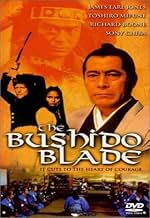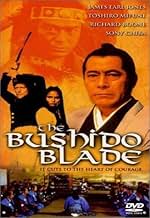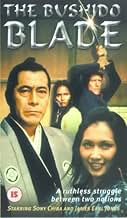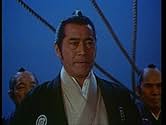A steel samurai blade that was to be given to the American ambassador by the Emperor of Japan is stolen. American sailors and Japanese samurai are sent to find it.A steel samurai blade that was to be given to the American ambassador by the Emperor of Japan is stolen. American sailors and Japanese samurai are sent to find it.A steel samurai blade that was to be given to the American ambassador by the Emperor of Japan is stolen. American sailors and Japanese samurai are sent to find it.
Mike Starr
- Bos'n Cave Johnson
- (as Michael Starr)
Timothy Patrick Murphy
- Midshipman Robin Burr
- (as Timothy Murphy)
Shin'ichi Chiba
- Prince Ido
- (as Sony Chiba)
Hitoshi Ômae
- Sumo
- (as Kin Omai)
- Director
- Writer
- All cast & crew
- Production, box office & more at IMDbPro
Featured reviews
Great cast. Too bad the rest of it couldn't match up.
Richard Boone plays a growling Cmmdr. Perry in his last role. And REALLY chews it up.
Frank (Coronet Blue) Converse (The real star) attempts to be an action hero. Not enough action though. And He's a little wooden.
Any Asian actor with a name dropped by for a cameo. Seeing the late, great Toshiro Mifune reprise most of his previous samurai roles was nice. And Sonny Chiba's warrior cliché is something I never get tired of. Then there's Mako as the cliché' wise man.
Laura (GODDESS) Gemser showing up made it worth the price of a rental. (To me anyway. She is GORGEOUS.) Seeing a young Mike Starr was kind of cool. He was obviously meant to be comedy relief.
James Earl Jones role should have been larger. Is this film still cut? An adventure story about finding a stolen sword could have and should have been a lot better.
And that minstrel show on the ship might anger a few people...even if it is based on facts of the times.
Not a waste...not unmissable either.
Richard Boone plays a growling Cmmdr. Perry in his last role. And REALLY chews it up.
Frank (Coronet Blue) Converse (The real star) attempts to be an action hero. Not enough action though. And He's a little wooden.
Any Asian actor with a name dropped by for a cameo. Seeing the late, great Toshiro Mifune reprise most of his previous samurai roles was nice. And Sonny Chiba's warrior cliché is something I never get tired of. Then there's Mako as the cliché' wise man.
Laura (GODDESS) Gemser showing up made it worth the price of a rental. (To me anyway. She is GORGEOUS.) Seeing a young Mike Starr was kind of cool. He was obviously meant to be comedy relief.
James Earl Jones role should have been larger. Is this film still cut? An adventure story about finding a stolen sword could have and should have been a lot better.
And that minstrel show on the ship might anger a few people...even if it is based on facts of the times.
Not a waste...not unmissable either.
I feel absolutely terrible giving a Toshiro Mifune film 4/10, but I could not do otherwise and remain honest. Frankly, the only acting in this movie that didn't leave me cringing was from the three main Japanese actors, (Sonny Chiba, Toshiro Mifune and Mako) and James Earl Jones who only had a tiny part. Frank converse didn't do a terrible job, but it wasn't a very enthusiastic performance. The rest of the actors deserve little more than scorn. Commodore Perry (Richard Boone) left me absolutely cringing every time he opened his mouth.
Frankly there was little, if anything, in this movie to recommend watching it. The culture is portrayed in a caricature manner, if not outright incorrectly. The history is wrong. The acting is terrible. The action scenes are decent, but not worth much.
I wouldn't say avoid this movie at all costs, but don't go out of your way to see it either.
Frankly there was little, if anything, in this movie to recommend watching it. The culture is portrayed in a caricature manner, if not outright incorrectly. The history is wrong. The acting is terrible. The action scenes are decent, but not worth much.
I wouldn't say avoid this movie at all costs, but don't go out of your way to see it either.
Bushido Blade is a film that kind of got lost with all the hoopla surrounding the Shogun TV mini-series. Commodore Perry's opening of Japan deserved a better treatment than what it got here.
No reflection on the cast, they certainly try hard enough. And the making of the film is a service of sorts because America is woefully ignorant about Japan other than knowing that they were our opponents in World War II.
Making his farewell appearance on the screen is Richard Boone as the crusty Commodore Matthew Calbraith Perry. From what little I know of Perry, Boone seems to have captured him very well. Perry was the younger brother of Oliver Hazard Perry who was the commander of the Great Lakes Navy that beat the British and kept them from invading us through Canada. Younger brother Cal (family and friends used Perry's middle name when addressing him)served in the United States Navy for over 30 years and the opening of Japan was the capstone of a great career.
Bushido Blade is a fictional sideline to the true events surrounding the treaty Perry signed with the Shogun. There was a faction in Japan who wanted to keep the country's isolationist policy going and were quite willing to do anything in that endeavor. They steal a ceremonial samurai sword that is to be presented to President Franklin Pierce by Perry. As this is a question of honor, the Japanese balk at signing the treaty at the last minute.
The Japanese insist on themselves recovering the sword, but Perry unofficially sends Marine Captain Frank Converse, Boatswain Mike Starr, and young Naval Midshipman Timothy Patrick Murphy on his own mission. The three get split up during an attack. The bulk of the film is the separate experiences of all three.
Frank Converse is a fine actor, but I couldn't quite believe him as an instant Samurai. When he has to battle the champion Samurai he gets a bit of help to say the least. Skill with a Samurai sword is not something one learns on the job or on the fly and by rights he should never have survived.
Young Timothy Patrick Murphy cuts a fine romantic figure as his odyssey includes a small romantic interlude with a young Japanese girl who is intrigued by this occidental who speaks her language. Murphy reminded me just a bit of Tyrone Power in Son of Fury. It was sad indeed that he died so young of AIDS, he had a great career ahead of him.
Such fine Japanese players as Toshiro Mifune, Tetsuro Tamba, and Mako fill their roles well. I very much enjoyed James Earl Jones who played a whaling harpooner who was a prisoner. Before the treaty was signed with Japan, sailors from the west who had the misfortune to be shipwrecked in Japan could expect never to see home again.
The Bushido Blade is an average film about a key incident in both American and Japanese history. It could have used a lot more of everything, direction, production values, editing. But the players did their best with it.
A good triple feature one day might be watching The Barbarian and the Geisha even with a woefully miscast John Wayne, The Bushido Blade, and the best film on 19th century Japan after the opening, The Last Samurai with Tom Cruise. It's a chance to see the Japanese as more than our enemies in World War II or having their city's destroyed by some prehistoric beast.
No reflection on the cast, they certainly try hard enough. And the making of the film is a service of sorts because America is woefully ignorant about Japan other than knowing that they were our opponents in World War II.
Making his farewell appearance on the screen is Richard Boone as the crusty Commodore Matthew Calbraith Perry. From what little I know of Perry, Boone seems to have captured him very well. Perry was the younger brother of Oliver Hazard Perry who was the commander of the Great Lakes Navy that beat the British and kept them from invading us through Canada. Younger brother Cal (family and friends used Perry's middle name when addressing him)served in the United States Navy for over 30 years and the opening of Japan was the capstone of a great career.
Bushido Blade is a fictional sideline to the true events surrounding the treaty Perry signed with the Shogun. There was a faction in Japan who wanted to keep the country's isolationist policy going and were quite willing to do anything in that endeavor. They steal a ceremonial samurai sword that is to be presented to President Franklin Pierce by Perry. As this is a question of honor, the Japanese balk at signing the treaty at the last minute.
The Japanese insist on themselves recovering the sword, but Perry unofficially sends Marine Captain Frank Converse, Boatswain Mike Starr, and young Naval Midshipman Timothy Patrick Murphy on his own mission. The three get split up during an attack. The bulk of the film is the separate experiences of all three.
Frank Converse is a fine actor, but I couldn't quite believe him as an instant Samurai. When he has to battle the champion Samurai he gets a bit of help to say the least. Skill with a Samurai sword is not something one learns on the job or on the fly and by rights he should never have survived.
Young Timothy Patrick Murphy cuts a fine romantic figure as his odyssey includes a small romantic interlude with a young Japanese girl who is intrigued by this occidental who speaks her language. Murphy reminded me just a bit of Tyrone Power in Son of Fury. It was sad indeed that he died so young of AIDS, he had a great career ahead of him.
Such fine Japanese players as Toshiro Mifune, Tetsuro Tamba, and Mako fill their roles well. I very much enjoyed James Earl Jones who played a whaling harpooner who was a prisoner. Before the treaty was signed with Japan, sailors from the west who had the misfortune to be shipwrecked in Japan could expect never to see home again.
The Bushido Blade is an average film about a key incident in both American and Japanese history. It could have used a lot more of everything, direction, production values, editing. But the players did their best with it.
A good triple feature one day might be watching The Barbarian and the Geisha even with a woefully miscast John Wayne, The Bushido Blade, and the best film on 19th century Japan after the opening, The Last Samurai with Tom Cruise. It's a chance to see the Japanese as more than our enemies in World War II or having their city's destroyed by some prehistoric beast.
A co-production between Japan and U.S. company Rankin/Bass, THE BUSHIDO BLADE (1979) was an attempt to capitalize on a growing interest in Japanese history which culminated the following year in the successful 'Shogun' TV miniseries and the English-dubbed samurai film, SHOGUN ASSASSIN, a re-edit of two films from the Japanese 'Lone Wolf and Cub' series. THE BUSHIDO BLADE, however, was the wrong film at the right time, despite the fact that it was shot in Japan with a mixed cast of American actors and Japanese stars. A fanciful account of Americans in Japan in 1854, it was ultimately undone by its low budget, lack of excitement, and contrived script.
It's set at the time of Commodore Matthew C. Perry's second trip to Japan, in February 1854, and his attempt to get a signed treaty with the Shogun. The basic plot borrows more than a little from the 1972 samurai western, RED SUN, and has to do with the theft of a sword intended for the U.S. president by a Japanese faction opposed to the treaty. Acting without orders, three Americans--a marine captain and two sailors, one of whom speaks a little Japanese--go off in pursuit of the sword and have numerous encounters in the Japanese countryside before the big confrontation at the castle of Lord Yamato, the nobleman behind the theft of the blade.
Quite improbably, the Americans encounter more than a few Japanese--five in all--who happen to speak adequate English, one of whom, Enjiro (played by Japanese-American actor Mako), is based on an actual historical figure, the fisherman Manjiro, who had been shipwrecked and taken to America some years earlier, but who actually had no interaction with the Americans during Perry's second trip. The other Japanese characters are all rather unlikely candidates to be proficient English speakers in 1854 Japan, but they include some big name actors. Toshiro Mifune (YOJIMBO) plays the Shogun's Commander; Sonny Chiba (THE STREET FIGHTER) plays Prince Ido, a foe of Yamato; and Tetsuro Tamba (YOU ONLY LIVE TWICE) plays Lord Yamato. Laura Gemser seems to have wandered in from Italian exploitation films (the EMANUELLE series) to play a half-Japanese, half-'foreign' English-speaking female samurai who beds the American captain.
The only big names in the American cast are Richard Boone, a one-time TV star ('Have Gun, Will Travel') and character actor in his final film role (as Commodore Perry), and James Earl Jones, who has a cameo as a shipwrecked sailor who's been held by the Japanese for two years. The biggest American part, Captain Hawk, is played by Frank Converse, primarily a TV actor ('NYPD'), who is actually quite good at portraying America's particular 19th century brand of arrogance and self-importance. Timothy Murphy plays the young American lieutenant who becomes enamored of Japanese culture (and falls for a Japanese woman). Mike Starr, later a prominent character actor and comic player (GOODFELLAS, ED WOOD, DUMB AND DUMBER), appears in his first film as burly sailor Cave Johnson, who takes on a sumo wrestler in one of the film's comic sidebars.
Overall, the film is of interest to Japan buffs and samurai fans, but it's bound to be a disappointment to most others because of its hackneyed story, stilted direction and TV-movie style of shooting. The film got very little theatrical release in the U.S. and went straight to television in most areas.
It's set at the time of Commodore Matthew C. Perry's second trip to Japan, in February 1854, and his attempt to get a signed treaty with the Shogun. The basic plot borrows more than a little from the 1972 samurai western, RED SUN, and has to do with the theft of a sword intended for the U.S. president by a Japanese faction opposed to the treaty. Acting without orders, three Americans--a marine captain and two sailors, one of whom speaks a little Japanese--go off in pursuit of the sword and have numerous encounters in the Japanese countryside before the big confrontation at the castle of Lord Yamato, the nobleman behind the theft of the blade.
Quite improbably, the Americans encounter more than a few Japanese--five in all--who happen to speak adequate English, one of whom, Enjiro (played by Japanese-American actor Mako), is based on an actual historical figure, the fisherman Manjiro, who had been shipwrecked and taken to America some years earlier, but who actually had no interaction with the Americans during Perry's second trip. The other Japanese characters are all rather unlikely candidates to be proficient English speakers in 1854 Japan, but they include some big name actors. Toshiro Mifune (YOJIMBO) plays the Shogun's Commander; Sonny Chiba (THE STREET FIGHTER) plays Prince Ido, a foe of Yamato; and Tetsuro Tamba (YOU ONLY LIVE TWICE) plays Lord Yamato. Laura Gemser seems to have wandered in from Italian exploitation films (the EMANUELLE series) to play a half-Japanese, half-'foreign' English-speaking female samurai who beds the American captain.
The only big names in the American cast are Richard Boone, a one-time TV star ('Have Gun, Will Travel') and character actor in his final film role (as Commodore Perry), and James Earl Jones, who has a cameo as a shipwrecked sailor who's been held by the Japanese for two years. The biggest American part, Captain Hawk, is played by Frank Converse, primarily a TV actor ('NYPD'), who is actually quite good at portraying America's particular 19th century brand of arrogance and self-importance. Timothy Murphy plays the young American lieutenant who becomes enamored of Japanese culture (and falls for a Japanese woman). Mike Starr, later a prominent character actor and comic player (GOODFELLAS, ED WOOD, DUMB AND DUMBER), appears in his first film as burly sailor Cave Johnson, who takes on a sumo wrestler in one of the film's comic sidebars.
Overall, the film is of interest to Japan buffs and samurai fans, but it's bound to be a disappointment to most others because of its hackneyed story, stilted direction and TV-movie style of shooting. The film got very little theatrical release in the U.S. and went straight to television in most areas.
Way back in 1980, I saw "The Bushido Blade" as a late night premiere on CBS. Much younger then, I was fairly impressed with the romance and action and the film was fondly remembered over the decades.
25 years later, the film comes out in DVD and I had to get it.
Well...
My disappointment was palpable. Richard Boone gives a loud, obnoxious performance as Commodore Matthew Perry, top billed James Earl Jones, while in fine voice and shape, only appears for about 2 minutes of screen time. The rugged Frank Converse comes off fairly well, but I can't understand why a Japanese actress was not cast as Tomoe instead of Laura Gemser. Sonny Chiba and Mako make good impressions, but something's not right when Mayumi Asano, playing Yuki, gives the best performance in the film. And this, with virtually no dialog. But, perhaps, that explains it right there.
Poorly written by William Overgard, a Rankin-Bass in-house hack, the story, beginning with an offensive minstrel show, is about the search by American sailors for a stolen ceremonial samurai sword, meant as a gift for the President of the United States in 1854 Japan. The three Americans are aided in their search by noble samurai Chiba and half-caste warrior Gemser. What bothers me most is the lack of any texture in the story. Most scenes take place against utilitarian sets with no detail. The countryside, where most of what passes as action takes place, is flatly filmed. Worst of all, none of the local Japanese have any significant dialog, and surprisingly, have no involvement in the story, but, act only as background color for the three or four major characters. Very strange. I think there are less than 10 speaking roles and half of those are of the "Yes, Sir. No, Sir" variety from extras.
After some disappointing samurai battle action over the sword against a lord and his poorly trained army of warriors...it just ends. You might be surprised by the suddenness of the fade out, but, that's all there is. I understand there is an alternate version running about 10 minutes longer, but, besides an extended ending, I can't imagine what might be missing or added to improve things. In retrospect, viewing the film after so many years brought back certain story reservations I had even as a youngster. Plot holes abound and the final fate of the sword and it's pursuers is not ironic as intended, but just leaves a bad taste in your mouth.
25 years later, the film comes out in DVD and I had to get it.
Well...
My disappointment was palpable. Richard Boone gives a loud, obnoxious performance as Commodore Matthew Perry, top billed James Earl Jones, while in fine voice and shape, only appears for about 2 minutes of screen time. The rugged Frank Converse comes off fairly well, but I can't understand why a Japanese actress was not cast as Tomoe instead of Laura Gemser. Sonny Chiba and Mako make good impressions, but something's not right when Mayumi Asano, playing Yuki, gives the best performance in the film. And this, with virtually no dialog. But, perhaps, that explains it right there.
Poorly written by William Overgard, a Rankin-Bass in-house hack, the story, beginning with an offensive minstrel show, is about the search by American sailors for a stolen ceremonial samurai sword, meant as a gift for the President of the United States in 1854 Japan. The three Americans are aided in their search by noble samurai Chiba and half-caste warrior Gemser. What bothers me most is the lack of any texture in the story. Most scenes take place against utilitarian sets with no detail. The countryside, where most of what passes as action takes place, is flatly filmed. Worst of all, none of the local Japanese have any significant dialog, and surprisingly, have no involvement in the story, but, act only as background color for the three or four major characters. Very strange. I think there are less than 10 speaking roles and half of those are of the "Yes, Sir. No, Sir" variety from extras.
After some disappointing samurai battle action over the sword against a lord and his poorly trained army of warriors...it just ends. You might be surprised by the suddenness of the fade out, but, that's all there is. I understand there is an alternate version running about 10 minutes longer, but, besides an extended ending, I can't imagine what might be missing or added to improve things. In retrospect, viewing the film after so many years brought back certain story reservations I had even as a youngster. Plot holes abound and the final fate of the sword and it's pursuers is not ironic as intended, but just leaves a bad taste in your mouth.
Did you know
- TriviaAlthough this film was derided as an attempt to copy the hit TV mini-series Shogun (1980), it was actually made in 1978, before Shogun (1980), though it wasn't released until after that series had aired.
- Crazy creditsThe producers gratefully acknowledge the cooperation of Toho Studios staff and personnel in the production of this picture.
- Alternate versionsFirst shown in USA in a 92-minute version on cable television, prior to a theatrical release in the USA of the complete 104-minute version, this retitled "The Bloody Bushido Blade."
- ConnectionsFeatured in Vintage Video: 0249 The Bushido Blade (1981) (2021)
- How long is The Bushido Blade?Powered by Alexa
Details
Contribute to this page
Suggest an edit or add missing content
































